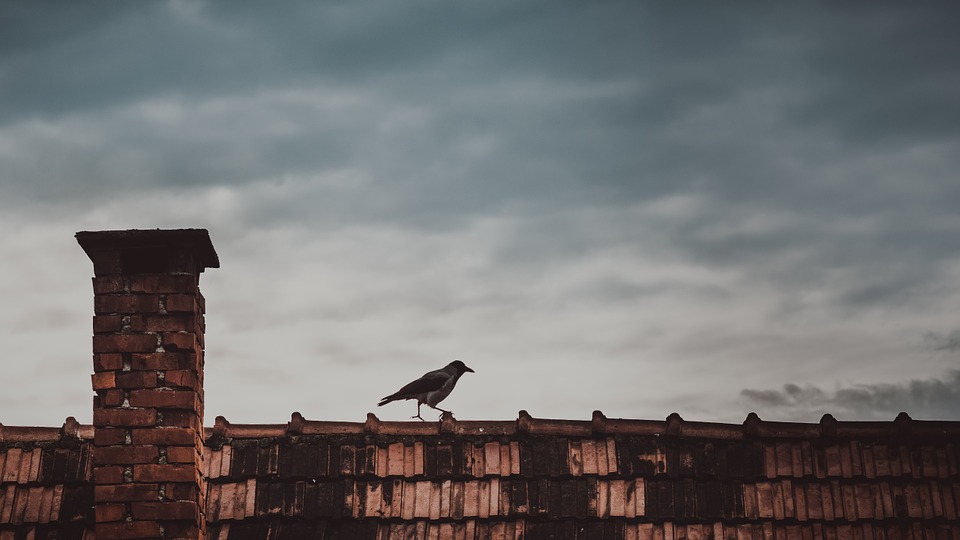essays
Winding Up the Dark Staircase: A Brief Survey of Haunted Houses
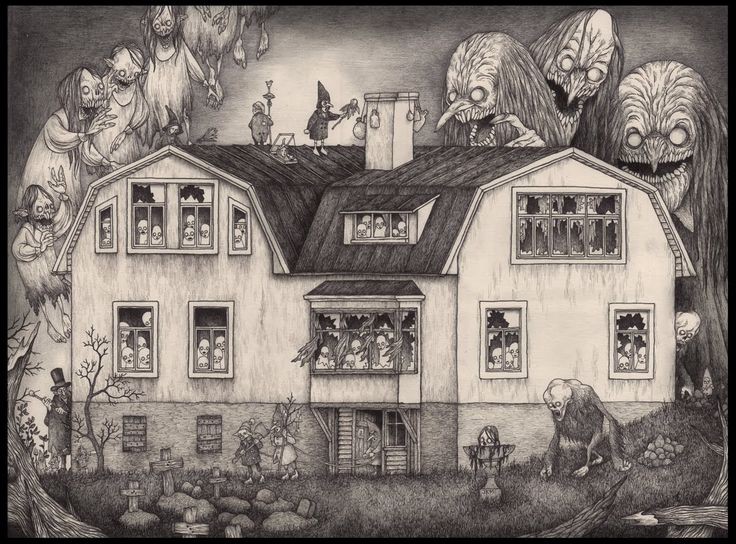
Edgar Allan Poe’s 1839 story “The Fall of the House of Usher” opens where haunted house stories should open — on the blighted prospects of the mansion itself. “I looked upon the scene before me,” Poe’s clinically observant narrator reports, “–upon the mere house, and the simple landscape features of the domain — upon the bleak walls — upon the vacant eye-like windows — upon a few rank sedges — and upon a few white trunks of decayed trees — with an utter depression of soul which I can compare to no earthly sensation more properly than to the after-dream of the reveler upon opium — the bitter lapse into every-day life — the hideous dropping off of the veil. There was an iciness, a sinking, a sickening of the heart — an unredeemed dreariness of thought which no goading of the imagination could torture into aught of the sublime. What was it — I paused to think — what was it that so unnerved me in the contemplation of the House of Usher?”
He does not tarry long in doubt.
By the end of the story, you’re left with two choices: Roderick Usher is either this nut who committed his sister a couple days early to the ancestral tomb lying under the house, only to have her return with a vengeance. Or Madeleine Usher, Roderick’s sister, really is the walking dead come back to claim Roderick for incest-y reasons, or maybe just the family curse. After Madeleine tackles her brother headlong, “[bearing] him to the floor a corpse,” the Usher House comes down around them. Then it vanishes into an infernal chasm.
Whichever way you look at “Usher,” it isn’t a haunted house story — not really. There are no ghosts among the halls; if anything, Madeleine Usher’s a zombie. No suits of armor muster out. No ancestral portraits track women in nightgowns. Yet the story, in essence, can be nothing but. One need only look to those opening lines to see how “Usher” fits the bill: a tale in which setting — in this case a house — exacts baleful returns on the fates of the players. Setting is a character that bodes nobody any good. Haunted house stories are stories, at last, in which spaces and places of brooding aspect exert wounding influence on the souls that traverse them.
The listicle below names 10. Not all of them involve a house.
The Little Stranger by Sarah Waters (2009)
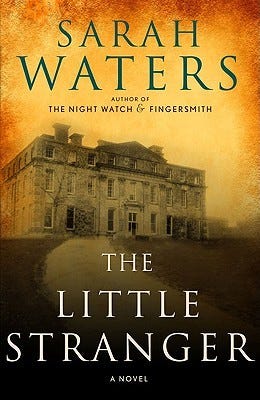
One of the more traditional haunted house stories you’ll find on this list, Waters’ novel groans into action when country-doctor Faraday arrives on a sick-call at Hundreds Hall, the rambling estate where his mother formerly served as a maid, to find the inhabitants living in a state of squeamish anomie, the mansion itself having fallen into magnificent disrepair around them. The patient in question is Roderick Ayres — that’s right, you heard me, dude’s named Roderick — who seems to be coming apart at the seams due to stressors far more than just keeping up Hundreds with only his mother and sister to help him. Given Waters’ previous forays into twisty Gothicism (Affinity and Fingersmith), which conclusively prove she’s the best writer ever, when the supernatural element comes into play you’ll neither be too much surprised, nor again when the phantoms are not what they seem. There’s also a really great dog-mauling scene. I should ask: what’s a Gothic ghost story without one?
Wild Fell by Michael Rowe (2014)
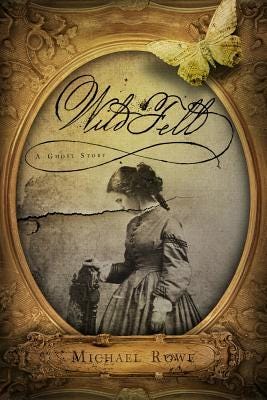
Following in Waters’ classical footsteps, this 2nd novel by Canadian author Michael Rowe fulfills the Hobbesian ideal of a haunted house novel: nasty, brutish and short. Also, elegant. With more than a little meta-fictional self-awareness — another trope of the haunted house novel post-1820, when the genre was already centuries old — Rowe tells the story of damaged ingénue Jameson Browning, who purchases the titular mansion on a lake-locked outcropping called Blackmore Island after an accident which puts him in possession of a sizable cash settlement. The ghosts are also real in Rowe, this time in the visage of Rosa Blackmore, a spectral teenager who makes known her presence in grim, strobic flashes around the estate. And yet, as in all the best haunted house stories, the specter in Wild Fell is more than just that; it’s a powerful human emotion made flesh — or un-flesh, as the case may be. While over it all loom the spires of Wild Fell: dwelt in by Jameson, dwelling in him.
The Cement Garden by Ian McEwan (1978)

The specters of lust, trauma and grief more concretely — ahem — haunt the pages of this early offering from McEwan, who is best known for stuffier, more novel-y novels like Atonement and Saturday. Shorter even than Wild Fell and possessed of a Freudian unsavoriness all its own, The Cement Garden reads like the kind of nightmare you can’t even bear to recount to yourself, wherein four siblings in a middle-class British family conceal the death of their mother in order to avoid being thrown into foster care by doing what anyone else would do in the same situation, of course: encasing her body in wet cement in the cellar of the house. They then proceed to run amuck, giving William Golding’s castaways a run for their money in their penchant for shattering incest taboos — a recurrent horror in early McEwan. All the while they’re contained by the space of the house, filling up with their mother’s putrescent perfume. Though the house isn’t haunted so much by mom’s ghost as the ghosts of the children they thought that they were.
In Evil Hour by Gabriel Garcia Marquez (1962)
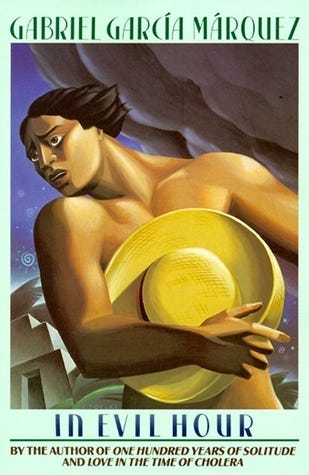
Livelier and more precise than Juan Rulfo’s Pedro Paramo, and less lugubrious than Isabelle Alende’s House of the Spirits, Garcia Marquez’s immediate precursor to One Hundred Years of Solitude concerns itself with a fictional river-town (a proto-Macondo) possessed by evil. Just like Wild Fell and The Cement Garden, In Evil Hour is uncharacteristically slim for a haunted house story; the novel is not even set in a house. Rather, it’s the town itself that cultivates maliciousness in all those who live there, first in the form of concerted lampoonings (Gabo calls them pasquinades) that air the citizenry’s secrets, and then later on as a government coup which subjugates the populace. Latin America’s answer to Needful Things, the novel also contains one of the tensest and most dislocating openings in the history of dark literature in which Cesar Montero, one rainy morning, goes to murder his wife’s lover Pastor as though in a trance, “[throwing] back the head of his raincoat, [releasing] the safety catch of the shotgun by feel, and with a calm, almost friendly voice [calling]: ‘Pastor.’” Afterward, the dying man drags himself across the floor with “the undulation of a worm along a furrow of tiny blood feathers.”
The Devil in Silver by Victor LaValle (2012)

“They brought the big man in on a winter night when the moon looked as hazy as the heart of an ice cube,” proceeds the riveting opening to LaValle’s third novel, in which Pepper, lummox-y furniture-mover, gets arrested and committed to down-at-heel New Hyde Hopsital after the romantic overture he makes toward a neighbor turns violent and humiliating. At New Hyde, when he’s not getting stalked by a hideous phantom with the body of an old man and the head of a bison which moves through the hospital’s air vents not unlike the xenomorph from Ridley Scott’s Alien, Pepper mixes with the patients — by turns terrifying and charmingly batty. Just like In Evil Hour, The Devil is Silver isn’t set in a house; instead, a psychiatric ward where papers are “lost” and where patients go “missing.” Yet the bureaucratic cluster-fuck of New Hyde Hospital comes to assert an uncanny and implacable influence over the fates of the characters. Pray they make it out alive.
The Sundial by Shirley Jackson (1958)
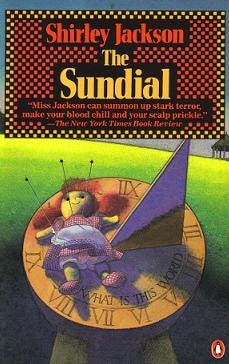
Meanwhile, in Victor LaValle’s eerie forward to Shirley Jackson’s The Sundial, he writes: “[the novel] shares some of the characteristics of Shirley Jackson’s most famous works of fiction. There’s the enormous, imposing estate, as in The Haunting of Hill House; the once great but now diminished family, as We Have Always Lived in the Castle, and even the doom-laden atmosphere of her classic short story “The Lottery.” So what makes The Sundial stand out? Why is it worth reading? Because The Sundial is funny as hell.” He’s right. Opening with the Halloran family’s return from laying to rest scion Lionel, pushed down the stairs by his very own mother — Mr. Halloran, a senile echo of Uncle Julian from We Have Always Lived in the Castle, continually relives his heartbreak: “Do you remember… we rang the bells over the carriage house when he was born?” — the novel then corrals its considerable cast of characters on the grounds of the estate for the duration where, amidst an atmosphere of growing claustrophobia and existential doom, melancholy seeress Aunt Fanny begins to receive messages from Beyond that presage the end of the world. As in much of Jackson, The Sundial draws its power not only from the terrifying isolation of the house itself but that very isolation juxtaposed against the threat of invading forces — the riffraff of the town below. It’s one thing to wallow in madness together; quite another for others, not mad, to bear witness.
Northanger Abbey by Jane Austen (1817)
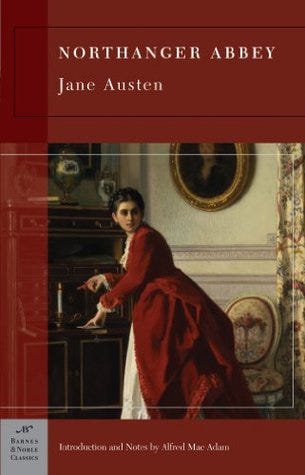
Supposedly the first novel Austen ever wrote — though it was published posthumously — Northanger Abbey, like The Sundial, is a spooky comedy of sorts, as well as an early example of meta-narrative blending between genre and literary fiction. In it, plucky heroine Catherine, obsessed with all things Gothic (prominently among them Ann Radcliffe’s novel Mysteries of Udolpho), gets invited by her prospective in-laws, the Tinley’s, to pass a few weeks with them at their ancestral home Northanger Abbey, which boasts a mysterious suite of rooms into which no one ever ventures, and a set of equally mysterious circumstances surrounding the death of the elder Mrs. Tinley, much to our heroine’s morbid delight. Suffice to say that Austen’s treatment of the haunted house novel is more send-up than spook-show, though no less weighty for that fact. Northanger Abbey brilliantly sets up the terrors of being imprisoned in a haunted mansion as a foil for the terrors of being imprisoned by youthful uncertainty. Catherine, like all Austen’s heroines, blazes, like the lone candle flame in a poorly lit parlor.
Canaan’s Tongue by John Wray (2005)

Like Northanger Abbey, Wray’s curious and curiously underrated second novel of dastardly slave-stealers in the Civil War sets itself up as another meta-fictional satire of sorts, this time of the Samuel Clemens-variety, before hauling off into regions much darker. The novel begins: “There is a house…There is a river”; the house is Geburah Plantation, surrounded by a “finger-bowl of bare red clay,” while the river, of course, is the Ol’ Mississip’. Together, they harbor and nourish the nefarious mercenary aims of the Island 37 gang, a cabal of miscreants led by a messianic dwarf-preacher known as the Redeemer whose fortunes are dictated by the blighted eye of the closest thing the novel has to a protagonist, Virgil Ball. Narrated through a mash-up of shifting first-person POV’s, dime-store novel excerpts and enigmatic poetry, the novel begins and concludes in the house with American history, writ large, in-between. That Geburah Plantation itself may or may not harbor the wandering spirit of the Redeemer, who Virgil admits he has murdered in the novel’s opening pages, certifies Canaan’s Tongue as a haunted house story in which supernatural horrors and the horrors of slavery are always, grimly, neck and neck.
Beloved by Toni Morrison (1987)
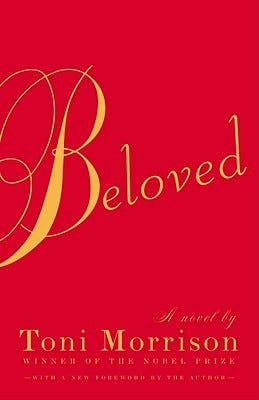
That one of the best novels ever written in English is also a haunted house story will serve as a boon to the Halloween reader, although please, for your own sake, don’t enter Beloved expecting any kind of romp. The novel, set alternately in pre and post-Bellum Ohio and Kentucky, begins: “124 was spiteful. Full of baby’s venom.” “124,” we soon learn, is a house haunted by the ghost of the daughter of the novel’s protagonist, former slave Sethe, who mercy-killed her years before rather than see her re-enslaved. If you’re worried, be worried, the novel gets grimmer but also, progressively, less realistic; the natural world, de-naturalized, begins to adopt a Macbethian role in deciding the fates of the narrative’s players, and the ghost conceit morphs into something vampiric. Much like Canaan’s Tongue, which was I’m guessing was influenced by Morrison’s book, the novel’s chronology shifts and evolves between Sethe’s PTSD-beset present and past, evoking the horrors of slavery, sure, but also its legacy, here, in the now (a wonderful companion piece is Jamaica Kindcaid’s short story “Ovando”). Not to mention it ends in the place it began, the venomous property 124, where Sethe and her teen daughter Denver still live, although now with a newly material presence. When the book’s Gothic horror approaches its zenith, “haunted house” shows itself as a relative term.
The Fall of the House of Walworth: A Tale of Madness and Murder in Gilded Age America by Geoffrey O’Brien (2010)
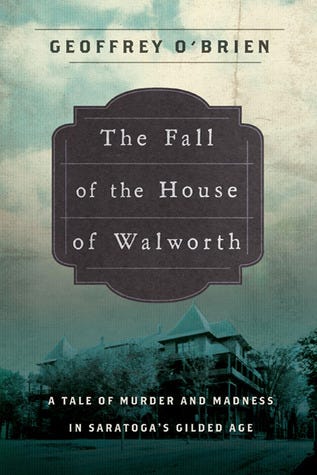
Rounding out our host of 19th-century-inflected haunted house stories while hearkening back to Poe’s seminal tale, Library of America editor O’Brien’s non-fictional account of the high tragic flameout of a prominent Saratoga Springs family evokes the ballroom shade-casting of the best of Edith Wharton alongside other contemporaneous works of historical true crime such as Erik Larson’s The Devil in the White City and Simon Winchester’s The Professor and the Madman. As it first did in Poe and now, too, in O’Brien, the “House” here has a double-meaning: on the one hand, it’s the great “Pine Grove,” seat of the family’s paterfamilias, Rueben Hyde Walworth, a NY-circuit judge; on the other, it’s the crumbling of the Walworth dynasty with enough castle intrigue to rival the Sutpens, when bloviating no-name novelist Mansfield, Rueben’s son, shot his father to death for unspecified reasons in his fancy NYC hotel room in 1867. The byzantine unraveling of those reasons, which involve a bitter boyhood, bloody pillows and a long, unnerving epistolary descent into madness, are both frightening and heartbreaking. If all of these stories have taught us one thing: a house, once haunted, cannot stand.
And wander these dark, branching halls, if you dare:
The Castle of Otranto by Horace Walpole (1764)
The Turn of the Screw by Henry James (1898)
Absalom, Absalom by William Faulkner (1936)
A Haunted House and Other Stories by Virginia Woolf (1944)
The Haunting of Hill House by Shirley Jackson (1959)
The House of Sleeping Beauties by Yasunari Kawabata (1961)
The Woman in the Dunes by Kobo Abe (1962)
We Have Always Lived in the Castle by Shirley Jackson (1962)
The Limeworks by Thomas Bernhard (1970)
Hell House by Richard Matheson (1971)
The Amityville Horror by Jay Anson (1977)
The Shining by Stephen King (1977)
Ghost Story by Peter Straub (1979)
House of Leaves by Mark Z. Danielewski (2000)
The Diary of Ellen Rimbauer: My Life at Rose Red by Ridley Pearson (2001)
The Keep by Jennifer Eagan (2006)
Audrey’s Door by Sarah Langan (2009)
Every House is Haunted by Ian Rogers (2012)
In the House Upon the Dirt Between the Lake and the Woods by Matt Bell (2013)






